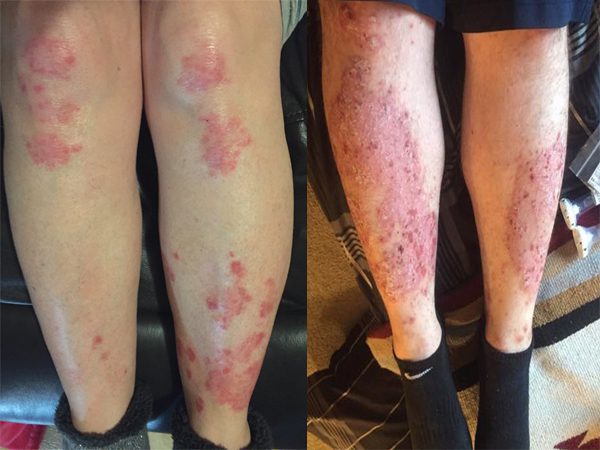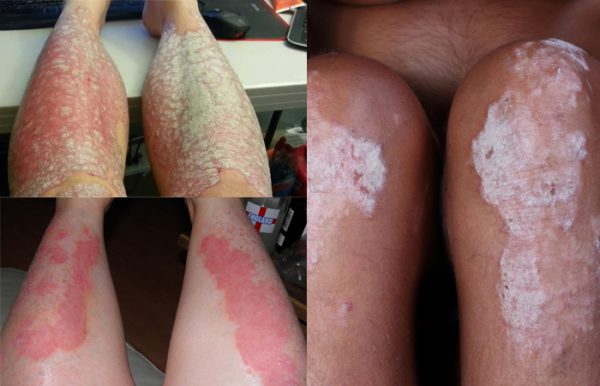Psoriasis on the legs takes various forms. The disease is manifested by the formation of papules and plaques on the hips, legs or feet. Leg injury can be of an isolated nature, and is characterized by a wavy course with periods of exacerbation and remission.
Symptoms
Psoriasis of the lower extremities is recognizable by the character of the skin lesion. First, small seals (nodules or papules) form on the legs, which eventually merge into large lesions called plaques. The skin on the surface of the plaques changes, becomes loose, begins strong peeling. This process is accompanied by the separation of scales. The epidermis acquires a bright shade in the lesion, the color can range from pink to violet.
Specific symptoms of foot injury:
- edema of the lower limbs;
- expressed itching;
- formation of pustules;
- changes in skin structure in the affected area.
Due to the characteristics of the epidermis of the lower extremities, the skin in the region of the plaques acquires a dense structure. The plaque-like lesion of the feet is accompanied by hyperkeratotic formations. These are dense crusts of yellowish color, reminiscent of neglected corns.
There are several clinical forms of the disease:
- plaque-like psoriasis, affecting the knees, feet and legs;
- limited pustular psoriasis, spreading from the lower leg to the foot;
- psoriatic arthritis, which causes inflammation of the joints.
Approximately 90% of patients with leg lesions are diagnosed with plaque-like psoriasis.
The most severe form of the disease is pustular inflammation of the feet. The skin in the affected area swells, is strongly flaky, pustules appear, filled with transparent contents. When walking pustules are damaged, purulent inflammation may develop. This form of the disease is accompanied by fever and severe pain of the affected area.
Diagnostics
Symptoms of the disease are quite specific, so it is not difficult to diagnose it. Even after a visual examination, the doctor can make a presumptive diagnosis. In addition, a sample is conducted for the so-called “psoriatic triad”. The method consists in analyzing the reaction of the skin to prolonged scraping, and can accurately diagnose vulgar psoriasis.
When the skin of the legs and feet is affected, a clinical and laboratory examination is performed: general and biochemical blood analysis, analysis for rheumatoid factor, seeding for sterility.
Treatment
The main groups of drugs for the treatment of psoriasis of the lower extremities:
- glucocorticosteroids for external use;
- indifferent ointments that soften the skin;
- preparations with calcipotriol (synthetic analogue of vitamin D).
Ointments with glucocorticosteroids have anti-inflammatory and antihistamine action, helping to calm the itching. When leg injuries prescribe drugs based on betamethasone (Beloderm, Soderm) or mometasone (Elokom and analogues).
Indifferent drugs are the main line of psoriasis treatment. They soften the skin, reduce peeling, accelerate regeneration. In therapy, use drugs with salicylic acid, zinc, sulfur. Combined drugs with salicylic acid and glucocorticosteroid are very effective.
Note: psoriasis of the lower limbs leads to the development of psoriatic arthritis or nail damage in half of patients.
It is impossible to completely cure psoriasis on the feet. Medications and physiotherapy are aimed at improving the quality of life of the patient and help achieve a stable remission.


